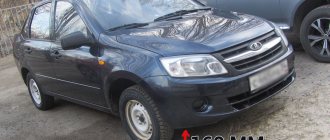Material characteristics
This model is a cylinder shape that is mounted under shock absorbers and suspension springs. Different materials of manufacture, density and dimensions of spacers for increasing ground clearance are determined by the purpose of installation on the front or rear of the car body. As a rule, the choice of one spacer or another does not depend on the make of the car: most parts are universal.
The material used to make parts can be divided into metal (steel or aluminum) and non-metal (polyurethane, plastic). Metal spacers are mounted under the spring, and non-metal spacers are mounted above the spring.
To have a clear idea of the subject, you can watch the installation of a spacer to increase ground clearance with your own hands in the video.
What are they needed for
I won’t be unfounded, but I’ll just give simple examples from life. I think they will allow you to understand why it is worth considering the issue of installing spacers to increase ground clearance.
- The car is initially quite low. This applies to imported cars, since our automakers understand that fighting the roads is pointless, as is waiting for their quality to improve. Therefore, they try to adapt to current conditions, offering high ground clearance. But even that is not enough. As a result, driving through the next section, you again and again cling to the bottom, crankcase protection, cannot pass the curb, brake before each hole so as not to get hit. All this interferes with normal movement and driving turns into a test.
- You often have to load the machine. A cabin full of people or a huge amount of luggage noticeably sits down the car, which begins to scrape along the asphalt and rub its wheels against the fender liners. Agree, this is not very pleasant.
Installing spacers is the most optimal solution to the problem, if you look at it from a price-quality perspective. They increase rigidity and increase the distance from the bottom to the ground. Fortunately, my car is quite high, but this problem is very close to me, since my friends do not have such ground clearance. Actually, I would like to install inserts for them too, since I have to constantly take my car if we go somewhere in nature or outside the city. But let's not talk about sad things.
I think it’s very clear to you why these spacers are needed and what function they perform. But before you install and even purchase these elements, which are sold not only in Volgograd, but also in any cities such as Moscow, St. Petersburg, Novosibirsk, Yekaterinburg, Krasnoyarsk, etc., I suggest you find out what these spacers are.
We recommend: How to determine what engine oil consumption is considered normal?
What is it for?
There are two reasons for raising the vehicle's ground clearance:
- off-road driving;
- sagging of springs over time.
To restore the spring to its original position, special spacers are used. The ideal option would be to replace old springs with new ones at a service station; however, car owners widely practice installing spacers to increase ground clearance with their own hands. If previously, increasing ground clearance was achieved by introducing tennis balls into the springs, now car dealerships sell special spacers of various thicknesses.
What is it about
Before you figure out what spacers are to increase ground clearance, you need to figure out what ground clearance is. clearance, in other words ground clearance , is the distance between the lowest point of the car body and the road.
Actually, why does a motorist need to increase the ground clearance? As already mentioned, various situations can lead to the fact that the ground clearance is reduced (damage to springs and fasteners, for example), or the factory one was not high enough. A car is, first and foremost, a means of transportation. A vehicle that sits tightly to the ground will not be able to drive without damaging the underbody. This can have a serious impact and make the car unsuitable for driving, which is why the question arises of increasing the distance to the road. Also, increasing the ground clearance is of interest to people who like to drive off-road.
So, increasing ground clearance is often done using special spacers. This is especially common in the case of subsidence of “native” springs. These spacers are spring mechanisms or additional fasteners. They cope with the task of increasing the clearance very well. Moreover, the procedure for attaching such magnifiers is the most accessible, since they themselves are not expensive - one spacer can be purchased for a price of 1000 rubles .
Air cylinders also cope just as well as spacers . It turns out even cheaper, and a “healthy” car with working springs does not suffer.
However, to decide whether such a modification is necessary, risk factors must also be taken into account. Of course, this idea has plenty of advantages, but it is not without its disadvantages - one way or another, any change in the “native” design always lies on the conscience of the motorist, and no one gives guarantees for its effectiveness. Before deciding to modify to increase ground clearance, weigh the pros and cons.
Pros and cons of the clearance operation
Is there really a need to tune the suspension, and will such a change damage the car? Before installing aluminum spacers under the springs, let’s pay attention to the positive aspects of the changes:
- protection of the rear suspension, underbody and crankcase from breakdowns;
- protection of the rear wheels from impacts on the fender liner;
- increasing the vehicle's off-road capability.
The disadvantages of installing a spacer under the springs with your own hands include:
- failure of the lower shock absorber mounting;
- additional load on the bottom bracket;
- car instability on an icy surface;
- impairment of vehicle controllability due to a shift in the center of gravity;
- rapid wear of steering parts;
- imbalance of wheel alignment.
After tuning, the car owner needs to pay more attention to the suspension in general and shock absorbers in particular.
The role of ground clearance and disadvantages
Let’s briefly understand what this ground clearance is and why it needs to be increased. They call it the distance from the road surface to the lowest point of the bottom of the car body. Many motorists change this parameter: some down, some up. But we will talk specifically about the increase, since good ground clearance allows you to drive on domestic roads with all their “delights” without problems. It is a set of spacers that is a relatively inexpensive way to increase ground clearance compared to more expensive technologies.
It would seem that spacers have the same advantages, but this is not entirely true. To be fair, I will say that there are some negative aspects to this method:
- deterioration in controllability and stability of the vehicle, which is especially noticeable when performing dynamic maneuvers and cornering;
- the possibility of incorrect camber and alignment, which leads to uneven tire wear;
- violation of the center of gravity provided by the manufacturer;
- increased wear of the vehicle's chassis components, as evidenced by reviews;
- reduction in the performance of shock absorbers.
What to choose?
What are spacers made of to increase ground clearance? The choice of material depends on the design of your machine. In the front compartment of the car, spacers made of metals are mounted: steel or aluminum alloys. It is recommended to place rubber or plastic products under the rear springs.
Which spacers are best for increasing ground clearance? Firstly, you cannot install any spacers over 30 mm thick. Secondly, polyurethane products can cause damage to the body by steel bushings due to rapid wear.
Aluminum products are the most reliable, although they cause corrosion at points of contact with the body. In practice, plastic spacers have shown themselves to work well to increase ground clearance, without revealing any serious shortcomings. Rubber material is the cheapest, but is prone to tearing, deformation and rapid wear.
About the body and suspension lift
Installation Rules
To properly make spacers for springs with your own hands, you need to take into account some nuances:
- Setting the ground clearance above 30 mm leads to wheel alignment problems.
- It is not recommended to install metal products that have not been pre-treated against corrosion.
- It is recommended to raise the front of the body by no more than 20 mm.
- The rear compartment of the body is raised by no more than 30 mm.
- If the shock absorber is not located next to the spring, spacers should be mounted under the springs and shock absorbers to balance the structure.
Front installation procedure
How to install spacers to increase ground clearance in the front part of the body? To do this, follow the recommendations:
- We lift the car with a jack, remove the tire, disconnect the braking system and the stabilizer link.
- We install other bolts of the required size on the rack (the old ones do not fit in length).
- We fix the spacer to the bolt and assemble the entire structure to its original state.
For greater clarity, you can see the diagram for installing a spacer to increase ground clearance with your own hands in the drawings.
Rear installation procedure:
- We disconnect the thresholds under the loading compartment lid and the rear door area.
- Move back the rear seats.
- We remove the panels and leave one body.
- We remove the wheel.
- We install the bolts according to the example of the front part of the body.
- We assemble the structure in reverse order.
If the word “jack” causes you vague anxiety, and the idea of the location of the bolts seems unclear, watch the procedure for installing a spacer under the springs in the video.
Installing spacers to increase ground clearance - how is it done?
If you have already decided on the material of the spacers and purchased a kit, all that remains is to decide where and how to install them. Most often, car owners turn to specialized centers to increase ground clearance, but you can show interest and do it yourself. How does the whole process of installing a spacer on the front pillar happen?
- First, we lift the car with a jack, remove the wheel, disconnect the brake hoses, then the stabilizer struts, and unscrew two more nuts on the front strut. To remove it completely, unscrew 3 more nuts on the upper support of the same front strut. In most cars you can reach them without problems, in some, for example, Toyota, you need to disassemble almost half the car, trying to get to the nuts on the hood side, removing the wiper panel, ventilation grilles, etc.
- Now you can take out the stand and start working magic on it. What immediately catches your eye is the “original” strut bolts, they are simply short for the additional pad that we would like to attach there. Therefore, we knock out the old bolts and insert new ones.
- We attach the spacer to the new bolts, and you can install everything in its place in the reverse order. If the spring of the transverse strut does not allow you to put everything in place, then it must be supported with something until it reaches the hole for the fastener. It is useless to press manually; use another jack.
Bottom line
When creating a car, design engineers calculate every millimeter, establishing a certain balance between the parts and assemblies of the vehicle. Any change made to the design of a car in order to improve technical characteristics introduces a certain imbalance into the overall structure.
It is not always possible to increase the cross-country ability of a car designed to drive on asphalt. No matter how hard you try to change or improve the condition of the suspension using various manipulations, you will not be able to improve the design to the condition of an SUV. Either buy an SUV, or resign yourself to driving on city highways.



